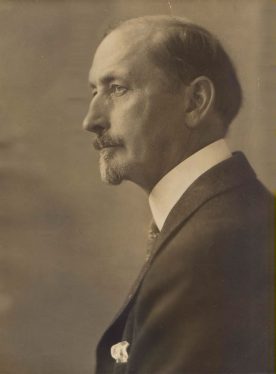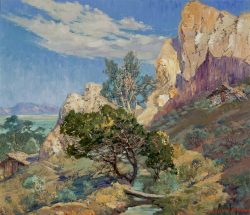Joseph P. Birren, from an undated photograph (www.findagrave.com).

Joseph Birren 1864/65–1933
Joseph Pierre Birren was born in Chicago and attended the Art Institute of Chicago. In 1885 he was the youngest in a group of artists hired to work on a cyclorama painting of the Battle of Gettysburg; he then traveled with a second, larger version of it as far as Australia. Birren studied in Paris and Munich for two years before going to New York to start a career as an illustrator. He returned to Chicago in 1892 and worked as a graphic artist and art director while painting landscapes of midwestern scenery as well as figure studies. Birren first exhibited at the Art Institute of Chicago in the 1895 annual exhibition of American art. Between 1896 and 1899 he was enrolled in the Art Institute’s evening class; later he attended the Art Students League in New York and the Pennsylvania Academy of the Fine Arts in Philadelphia, where he also participated in annual exhibitions. Along with Oliver Dennett Grover, Birren founded the Art Institute Alumni Association in 1911 and he served as its first president.
In 1916, Birren finally abandoned commercial art altogether to devote himself to painting, specializing in figural images and landscapes. He worked in coastal New England, in the artists’ haunts of Provincetown and Rockport, Massachusetts, and in Bermuda. In 1925, Birren went west with a commission to paint on the California coast, and landscapes dominated his output thereafter. He eventually purchased a home in Laguna Beach, site of a thriving colony of impressionist and modernist artists. He spent a season in Santa Fe, New Mexico, in 1927, and visited Europe several times between about 1929 and 1931. Birren developed an individual style of patterned paint application, termed “Tactilism,” and an individual manner of handling trees. His compositions were admired for their decorative and poetic qualities among critics and collectors interested in a “sane” modern art.
Birren was also a lecturer and organizer, serving as a president of the Palette and Chisel Club and the organization Allied Arts while also an active member of the Chicago Society of Artists, the Arts Club of Chicago (as a founding member), and other organizations. In 1921, he founded the Art Institute’s Birren Prize to encourage architects to consider the role of paintings in domestic interior design. In addition to the museum, where he had a solo show in 1924, Birren exhibited his works at such Chicago venues as the Chicago Galleries Association, the Hoosier Art Gallery, and the Marshall Field and Company department store. He also had solo exhibitions in Washington, D.C. (1923), Detroit (1923), Pittsburgh (1924), New York (1924, 1931), Los Angeles (1925, 1930), San Francisco (1925), Seattle (1927), Santa Fe (1927), and St. Louis (1930). In 1931, when Birren toured Europe to exhibit his paintings, he received a knighthood from the Duchy of Luxembourg, his parents’ birthplace. Birren was art director of the German-American building at A Century of Progress exposition in Chicago in 1933, the year of his death at age eighty-nine.
Wendy Greenhouse, PhD
